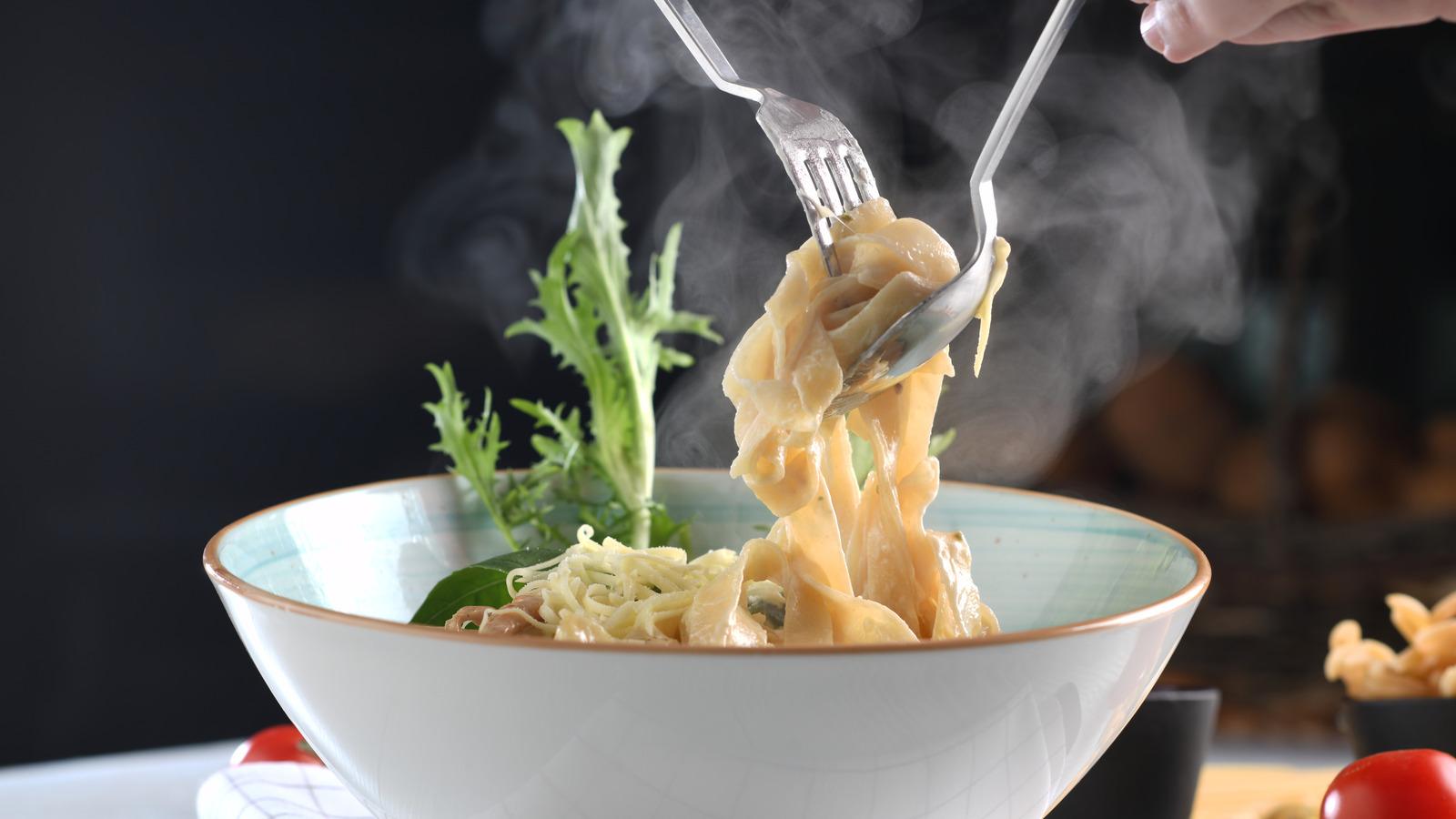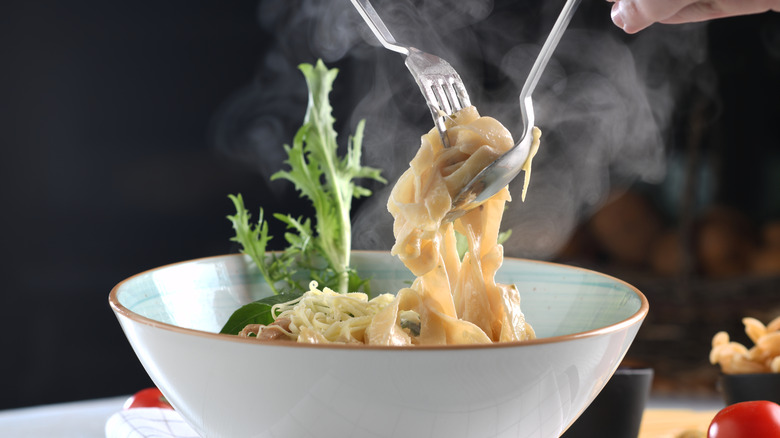
United Medya/Shutterstock
You love eating fettuccine Alfredo whenever you go to your favorite restaurant. But, when you try to make it at home, the sauce splits or the flavor is all wrong. This might leave you wondering why fettuccine Alfredo always tastes better at an Italian restaurant.
Joints that take Alfredo seriously don't have some huge secret. They make multiple small, intentional choices that add up to a very different dish. From the pasta itself to how the sauce is finished, each step is finely tuned to get the best results. That's what separates a perfectly decent, comforting homemade fettuccine Alfredo from one that tastes restaurant-worthy.
We wanted to get to the bottom of it, so we did some deep dive research into how good chefs and restaurants make fettuccine Alfredo. We look at how fresh pasta changes things, why salting the water is non-negotiable, what proper cheese choices bring, and how chefs expertly finish the dish.
There's nothing mystical here, just professional skills and techniques honed over thousands of plates of fettuccine Alfredo. The results speak for themselves, though. It's a simple dish, so small changes can make all the difference. Here are some of the reasons why fettuccine Alfredo from an Italian restaurant tastes better than homemade.
At quality Italian restaurants, the fettuccine is made from scratch
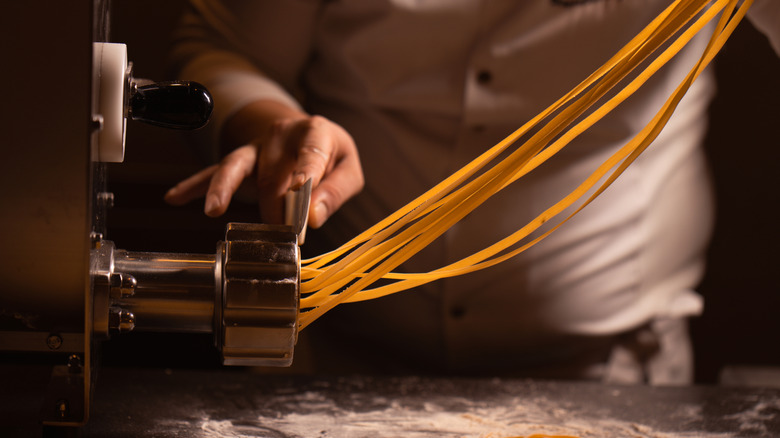
makcilpunar/Shutterstock
One of the clear differences between restaurant fettuccine Alfredo and the homemade version is the pasta itself. In a good Italian kitchen the fettuccine is often made in-house, rolled and cut from fresh dough. Or, if not, it may be sourced daily from a trusted local pasta maker.
Fresh pasta has a softer, more tender bite. This makes it particularly good for delicate sauces like Alfredo. The noodles blend in with the sauce beautifully, giving you less resistance and chew than dried pasta, especially when cooked al dente. Boxed noodles are denser and less capable of marrying with a buttery cheese emulsion.
Fresh dough also lets chefs tweak variables to customize their dough. For instance, Alfredo Alla Scrofa, the restaurant that invented Alfredo sauce, makes its noodles extra thin for the best consistency. You might also see choices like semolina-only dough for a toothier texture or dough made with extra eggs for richness. Those decisions are deliberate, letting restaurants make the kind of fresh pasta that best fits the dish the way they make it.
Choices like this really make restaurant fettuccine Alfredo stand out from your average homemade version. But, if you want to try it yourself, it's easy enough to make your own. Our homemade pasta recipe is a good place to start.
Chefs make sure to salt pasta water properly

Anton27/Shutterstock
Salting the pasta water might seem small, but it's something chefs do that makes a huge difference. Many people don't use enough salt in pasta water at home and this can leave the dish tasting bland, no matter how good your sauce is. The trouble is that people are scared of using too much salt — and the amount you should toss in a pan of pasta water can look scary. But the noodles only absorb a small amount of that, so it's not like you're consuming a lot.
Salt doesn't just season the surface; it seasons the pasta itself, so every strand has base-level flavor before sauce is applied. Alfredo is a fairly simple sauce, so it's even less likely to stand on its own if the pasta is under-salted than something more robust. In professional kitchens chefs are generous when salting pasta water, and home cooks should be too.
You should use approximately 1% salt to 99% water. This means using around 1½ teaspoons of fine salt per liter of water used, or around a tablespoon of kosher salt. Measuring this out is a good idea when you're starting out. However, after some time you'll get a feel for it and will find you can measure the salt roughly in the palm of your hand and toss it in. A little more or less is no problem.
Some Italian restaurants skip the heavy cream in fettuccine Alfredo
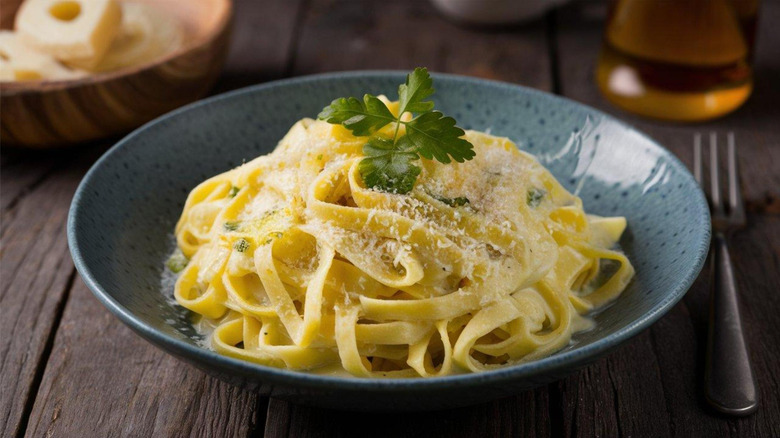
Food magic/Shutterstock
If you order an Alfredo at a chain — or in many Italian-American restaurants — you'll probably get a sauce that contains heavy cream. But back in Italy, the original way of making Alfredo sauce is different. And some good Italian restaurants in the U.S. have followed suit. In fact, some even use that original recipe.
The classic Italian approach relies on three main ingredients: butter, freshly grated Parmigiano-Reggiano, and fresh pasta. There's no heavy cream because the creaminess comes from technique, not dairy. Chefs use butter, cheese, and a splash of pasta water to make the sauce. The starch in that water emulsifies with the melted butter and cheese to form a sauce that's creamy without any actual cream.
A good butter, properly aged Parmigiano-Reggiano, and the right pasta thickness produce a sauce that tastes brighter but just as delicious. Heavy cream was the ingredient that Westernized Alfredo sauce. There's nothing wrong with enjoying it this way. It's an Italian-American classic for a reason. However, some people prefer the simpler ingredients. So, if the Alfredo in your favorite Italian restaurant tastes a bit different from others you've tried — rich but less heavy — it might be because the establishment skips the cream. Great Italian food is all about simplicity, so we'd highly recommend you try this version at least once.
Chefs at Italian restaurants have perfected their technique for finishing fettuccine Alfredo
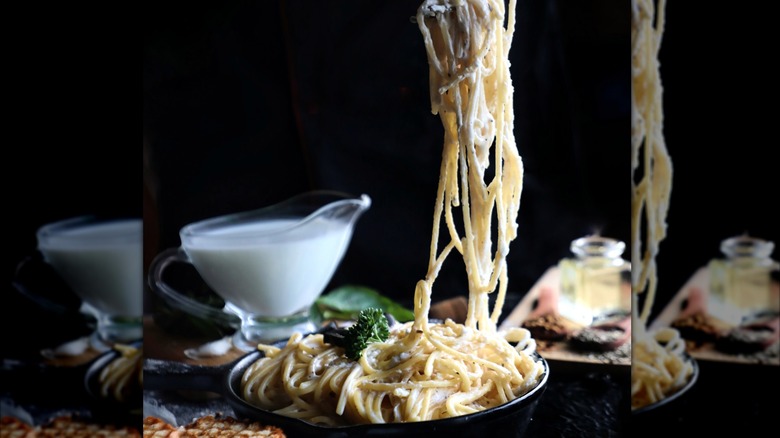
Sparsh Ahuja/Getty Images
One of the reasons why the texture of a good fettuccine Alfredo is on point is that chefs at Italian restaurants have gotten the finishing technique down pat. It's a simple sauce made of butter, cheese, and (often, in the U.S.) heavy cream. You'd think you could put all those in a pan, let the component parts melt, and call it a day. But this often results in a grainy sauce — or at least one that's not as silky smooth as it could be.
Italian chefs call the finishing technique "mantecatura," which loosely translates to "making it creamy." It involves plating the cooked pasta; adding Parmigiano-Reggiano, butter, and pasta water; and tossing everything carefully until the sauce emulsifies and becomes cohesively creamy. In restaurants in Italy, this is sometimes done right at the table.
You want a rough ratio of 2-to-1 cheese to butter and a splash of pasta water, if you're going without heavy cream. You may need to use some trial and error to get the amount of pasta water just right. Or, if you're using cream, equal parts cream, butter, and cheese usually gives great results. The beauty of Alfredo is that it's so simple you can easily play around with it until you get it to your liking. But the simplicity also means there's nowhere to hide when you get it wrong.
The choice of cheese is important when making fettuccine Alfredo
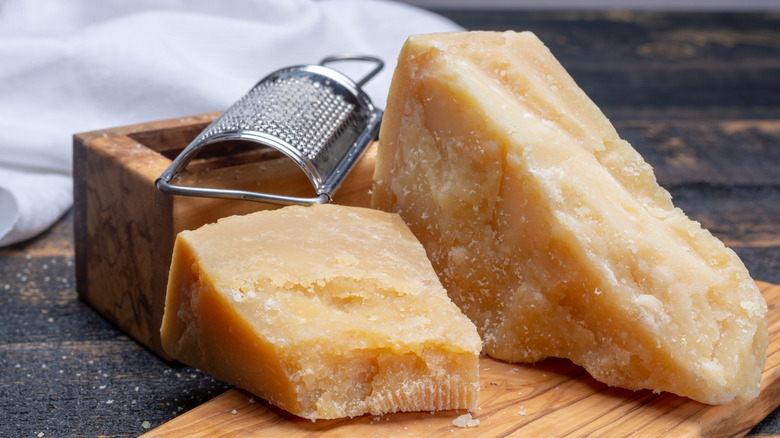
Barmalini/Getty Images
In a dish that is essentially butter and cheese, the cheese choice matters more than most people realize. Good kitchens favour aged Parmigiano-Reggiano because it delivers nutty complexity, along with crystalline umami notes. That's a far cry from the dust-like supermarket Parmesan shakers. Authentic Parmigiano-Reggiano is aged, savory, and has a granular quality that integrates beautifully into an emulsion. Even wedges of supermarket Parmesan are different from the Italian version.
This is the original choice and the one you'll find in most kitchens. Lesser establishments might try to get away with using lesser-quality generic Parmesan, but the difference is notable. With so few ingredients, every one matters, coming together to create a delicious pasta dish.
That said, some chefs prefer pecorino Romano, which is sharper and saltier. This is a matter of preference. It's not traditional, but chefs adapt recipes all the time, so if it's a conscious choice because they prefer the way it tastes, then great. Again, it should be of a good quality. This is what separates an Alfredo sauce that's perfectly tasty but not memorable from one that's so good, you'll be telling your friends about it for weeks.
There's also the option to mix Parmigiano-Reggiano and pecorino Romano. The mix increases savory depth and gives the sauce more backbone without overwhelming the butter. How the cheese is prepared matters too: chefs finely grate from a wedge minutes before assembly so the cheese is airy and melts evenly.
Chefs know how to control temperature so the sauce doesn't split
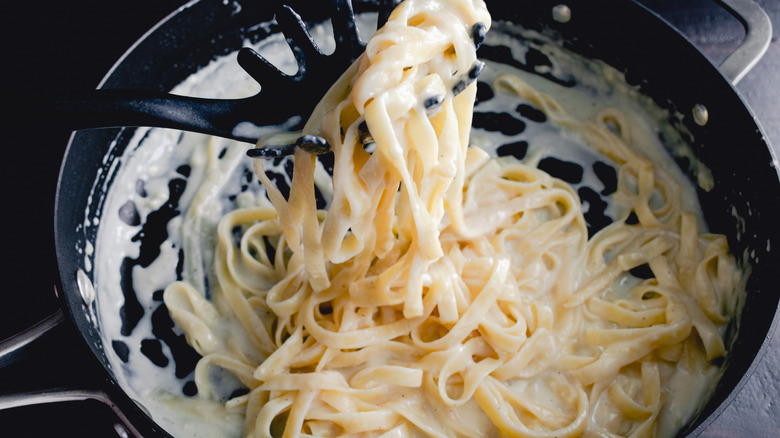
Candice Bell/Shutterstock
A perfect Alfredo is a delicate emulsion. Letting it split is one of the common mistakes people make with Alfredo sauce. Too much direct heat will make the fat separate from the cheese and water, turning a silky sauce into a greasy, grainy mess. Professional chefs control the temperature by working off heat. They often remove the pan from the burner before adding cheese, relying on residual warmth and vigorous tossing to coax the cheese into the butter without seizing.
However, if you're making it at home and you've already got to the stage where the sauce has split, sometimes a little hot pasta water is all you need to fix the emulsion. It doesn't have to be a lost cause. Once you've got it right, the emulsion is happiest right after assembly. If it sits too long or when you reheat any leftovers, it can cause the emulsion to break again.
In short, using gentle heat is the simple way chefs make Alfredo behave itself and keep the sauce from splitting. It's so easy that you'll wonder why you didn't try it before winding up with a bunch of failed attempts. Making your Alfredo sauce in the pan might seem like the obvious choice, but doing it off the heat is really the way to go.
Alfredo sauce from a restaurant is carefully reduced to get the right consistency
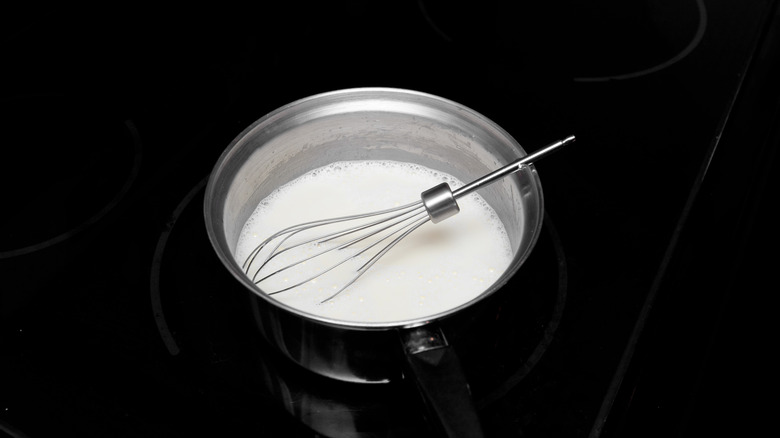
Matt Antonino/Shutterstock
If you're wondering why your favorite restaurant fettuccine Alfredo is perfectly thickened and creamy, while your homemade version is watery, it probably comes down to reduction. Chefs will simmer cream just until it loses a little volume and gains body, monitoring the temperature closely so the mixture doesn't scorch or become grainy. For those following along at home, all you need to do is keep your cream on a very low heat, stir frequently, and watch for the sauce to coat the back of a spoon.
Cheese plays a crucial supporting role in texture as well as flavor. Finely grated Parmigiano-Reggiano melts into the warm cream and helps the sauce thicken so it clings to the pasta. So, you don't need to get the cream quite as thick as you want the sauce. It's a delicate balance, because when you add cheese, you'll thicken the sauce, but mixing in some pasta water will thin it. Using the right amounts of these ingredients and reducing the cream the right amount will leave you with the right consistency.
Understanding reduction and thickening gives you practical ways to rescue a shaky home Alfredo and approximate restaurant versions. It can take a few tries to get it right. But don't be disheartened — professional chefs will have made it hundreds, if not thousands, of times.
There may be a garnish of fresh herbs for color and flavor
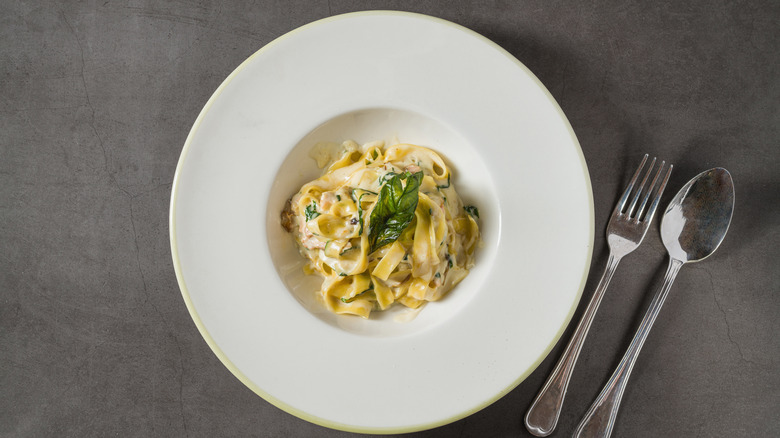
Yalcin Sonat/Shutterstock
A final flourish of fresh herbs is one of those small touches that lifts a bowl from homey to restaurant-ready. Chefs often finish fettuccine Alfredo with a scatter of finely chopped herbs. They taste good, but they also add some color to an otherwise pale, buttery sauce. So, to add more flavor to your sauce, you might want to do this with any homemade versions you put together.
Flat-leaf Italian parsley is the classic choice. It brings fresh, slightly peppery green notes that complement cheese and butter without overshadowing them. Basil adds sweet and savory notes and tilts the dish toward an Italian profile, while chives contribute a mild oniony lift. Chefs may cut herbs very fine so they integrate easily and sprinkle them at the last moment so volatile aromatics stay vivid when the plate arrives.
But chefs use these garnishes with some restraint. Too much herb distracts from the simple creaminess of the sauce. You don't want an Alfredo sauce that tastes heavily of basil, for instance, but a hint of it can be delicious.
Chefs expertly taste for salt and pepper

Julia Sudnitskaya/Shutterstock
Seasoning is where good pasta becomes memorable, and professional cooks taste repeatedly while making fettuccine Alfredo. A spoonful mid-assembly tells them whether the sauce needs a pinch of salt, a grind of pepper, or nothing at all. Because the dish hinges on few ingredients, seasoning needs to be approached carefully. Too much can easily unbalance the delicate sauce.
Chefs season at multiple points. The pasta water is salted to impart base seasoning, the sauce base receives a measured amount of salt during reduction, and the final toss often includes a last-minute adjustment after cheese is added. Those staggered seasoning moments ensure the flavor is even and integrated rather than fixed at the end. That said, black pepper is usually cracked fresh to release its fragrant oils, so it may be added right at the end.
Because Parmigiano-Reggiano and pecorino are naturally salty, chefs taste rather than following an exact measurement every time. If you blindly throw in salt, you can easily end up overdoing it. So, start with a little, taste as you go, and ensure the perfect balance.
Restaurant chefs may have aromatics in their Alfredo recipes

Nurulhu87/Shutterstock
While purists might argue that true fettuccine Alfredo should stick to butter, Parmesan, and pasta, some restaurants take small creative liberties by adding aromatics. A little finely minced shallot, for example, can bring sweetness and depth. Fresh garlic, used with a light hand, can add fragrant notes without overpowering the cheese. These additions aren't about reinventing the dish so much as layering in subtle background notes.
The key is balance. Too much garlic and the sauce can become harsh; too much shallot and you risk overshadowing the delicate cheese flavor. Skilled chefs know how to sweat aromatics slowly in butter until they soften and mellow, creating a base that subtly enhances flavors rather than distracting from the creamy richness of Alfredo sauce. In some cases, the aromatics are strained out before serving, leaving only their infused flavor.
For diners, these tweaks can make Alfredo feel a little more complex without straying so far from tradition that it becomes unrecognizable. Restaurant chefs aren't just following recipes, they're using experience and instinct to decide when a small change might make a big impact. So, if you think there's something missing from your homemade Alfredo, it could be flavorful aromatics.
Chefs think about ingredient quality
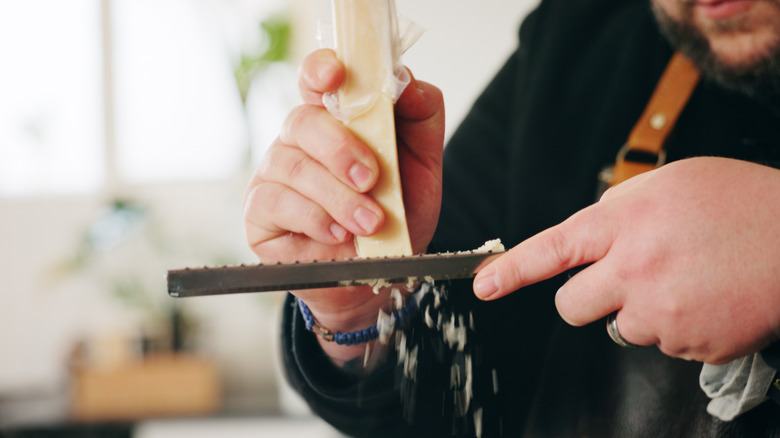
PeopleImages.com - Yuri A/Shutterstock
Fettuccine Alfredo might be simple, but simplicity shines the spotlight right on the quality of each ingredient. With so few components — pasta, butter, cheese, pasta water, and perhaps heavy cream — there's nowhere for subpar products to hide. That's why chefs go out of their way to source the best they can get.
Take the cheese: a wedge of well-aged Parmigiano-Reggiano has a complexity, nuttiness, and crystalline texture you'll never get from a bag of pre-grated Parmesan. The butter matters too — higher-fat butters with a sweet, creamy flavor give the sauce a richer finish. Some restaurants only use grass-fed butter. And then there's the pasta. Fresh egg pasta, often made in-house or sourced from artisanal suppliers, tastes so much better than dry pasta or a bag of fresh pasta from the grocery store.
Restaurants also have access to specialty suppliers that most home cooks don't. While a supermarket option might get the job done, the difference in flavor and texture between an average grocery store cheese and the kind a chef selects can be striking. In a dish this pared-back, ingredient quality isn't an afterthought, it's a huge part of the entire experience. That's why, in the right hands, restaurant fettuccine Alfredo can taste incredible even with such a short ingredient list.



